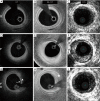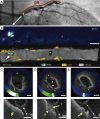The role of intracoronary imaging in translational research
- PMID: 33224769
- PMCID: PMC7666942
- DOI: 10.21037/cdt-20-1
The role of intracoronary imaging in translational research
Abstract
Atherosclerotic cardiovascular disease is a key public health concern worldwide and leading cause of morbidity, mortality and health economic costs. Understanding atherosclerotic plaque microstructure in relation to molecular mechanisms that underpin its initiation and progression is needed to provide the best chance of combating this disease. Evolving vessel wall-based, endovascular coronary imaging modalities, including intravascular ultrasound (IVUS), optical coherence tomography (OCT) and near-infrared spectroscopy (NIRS), used in isolation or as hybrid modalities, have been advanced to allow comprehensive visualization of the pathological substrate of coronary atherosclerosis and accurately measure temporal changes in both the vessel wall and plaque characteristics. This has helped further our appreciation of the natural history of coronary artery disease (CAD) and the risk for major adverse cardiovascular events (MACE), evaluate the responsiveness to conventional and experimental therapeutic interventions, and assist in guiding percutaneous coronary intervention (PCI). Here we review the use of different imaging modalities for these purposes and the lessons they have provided thus far.
Keywords: Coronary artery disease (CAD); intracoronary imaging; intravascular ultrasound (IVUS); near-infrared spectroscopy (NIRS); optical coherence tomography (OCT); plaque imaging.
2020 Cardiovascular Diagnosis and Therapy. All rights reserved.
Conflict of interest statement
Conflicts of Interest: All authors have completed the ICMJE uniform disclosure forms (available at http://dx.doi.org/10.21037/cdt-20-1). The series “Intracoronary Imaging” was commissioned by the editorial office without any funding or sponsorship. SJN reports grants from AstraZeneca, Amgen, Anthera, Eli Lilly, Esperion, Novartis, Cerenis, The Medicines Company, Resverlogix, InfraReDx, Roche, Sanofi-Regeneron and LipoScience, personal fees from AstraZeneca, Akcea, Eli Lilly, Anthera, Omthera, Merck, Takeda, Resverlogix, Sanofi-Regeneron, CSL Behring, Esperion, Boehringer Ingelheim, outside the submitted work. In addition, SJN has a patent as a named inventor on a patent for the use of PCSK9 inhibitors and their impact on atherosclerotic plaque, Issued. PJP reports personal fees from ESPERION Therapeutics, Bayer, Boehringer Ingelheim, Merck, Pfizer, Astra Zeneca, grants from ABBOTT Vascular, outside the submitted work. SJN serves as an unpaid editorial board member of Cardiovascular Diagnosis and Therapy from Jul 2019 to Jun 2021. PJP serves as an unpaid editorial board member of Cardiovascular Diagnosis and Therapy from Aug 2019 to Jul 2021. The authors have no other conflicts of interest to declare.
Figures



Similar articles
-
The Role of Intracoronary Plaque Imaging with Intravascular Ultrasound, Optical Coherence Tomography, and Near-Infrared Spectroscopy in Patients with Coronary Artery Disease.Curr Atheroscler Rep. 2016 Sep;18(9):57. doi: 10.1007/s11883-016-0607-0. Curr Atheroscler Rep. 2016. PMID: 27485540 Review.
-
Therapeutic modulation of the natural history of coronary atherosclerosis: lessons learned from serial imaging studies.Cardiovasc Diagn Ther. 2016 Aug;6(4):282-303. doi: 10.21037/cdt.2015.10.02. Cardiovasc Diagn Ther. 2016. PMID: 27500089 Free PMC article. Review.
-
Near-Infrared Spectroscopy Intravascular Ultrasound Imaging: State of the Art.Front Cardiovasc Med. 2020 Jun 30;7:107. doi: 10.3389/fcvm.2020.00107. eCollection 2020. Front Cardiovasc Med. 2020. PMID: 32695796 Free PMC article. Review.
-
Role of intravascular ultrasound and optical coherence tomography in intracoronary imaging for coronary artery disease: a systematic review.J Geriatr Cardiol. 2024 Jan 28;21(1):104-129. doi: 10.26599/1671-5411.2024.01.001. J Geriatr Cardiol. 2024. PMID: 38440344 Free PMC article.
-
In vivo imaging of vulnerable plaque with intravascular modalities: its advantages and limitations.Cardiovasc Diagn Ther. 2020 Oct;10(5):1461-1479. doi: 10.21037/cdt-20-238. Cardiovasc Diagn Ther. 2020. PMID: 33224768 Free PMC article. Review.
Cited by
-
Tandem lesions associate with angiographic progression of coronary artery stenoses.Int J Cardiol Heart Vasc. 2024 May 3;52:101417. doi: 10.1016/j.ijcha.2024.101417. eCollection 2024 Jun. Int J Cardiol Heart Vasc. 2024. PMID: 38725440 Free PMC article.
-
Incretin-based therapies for the management of cardiometabolic disease in the clinic: Past, present, and future.Med Res Rev. 2025 Jan;45(1):29-65. doi: 10.1002/med.22070. Epub 2024 Aug 14. Med Res Rev. 2025. PMID: 39139038 Free PMC article. Review.
-
In vivo fluorescence imaging: success in preclinical imaging paves the way for clinical applications.J Nanobiotechnology. 2022 Oct 15;20(1):450. doi: 10.1186/s12951-022-01648-7. J Nanobiotechnology. 2022. PMID: 36243718 Free PMC article. Review.
-
Automated Coronary Optical Coherence Tomography Feature Extraction with Application to Three-Dimensional Reconstruction.Tomography. 2022 May 17;8(3):1307-1349. doi: 10.3390/tomography8030108. Tomography. 2022. PMID: 35645394 Free PMC article.
References
Publication types
LinkOut - more resources
Full Text Sources
Miscellaneous
